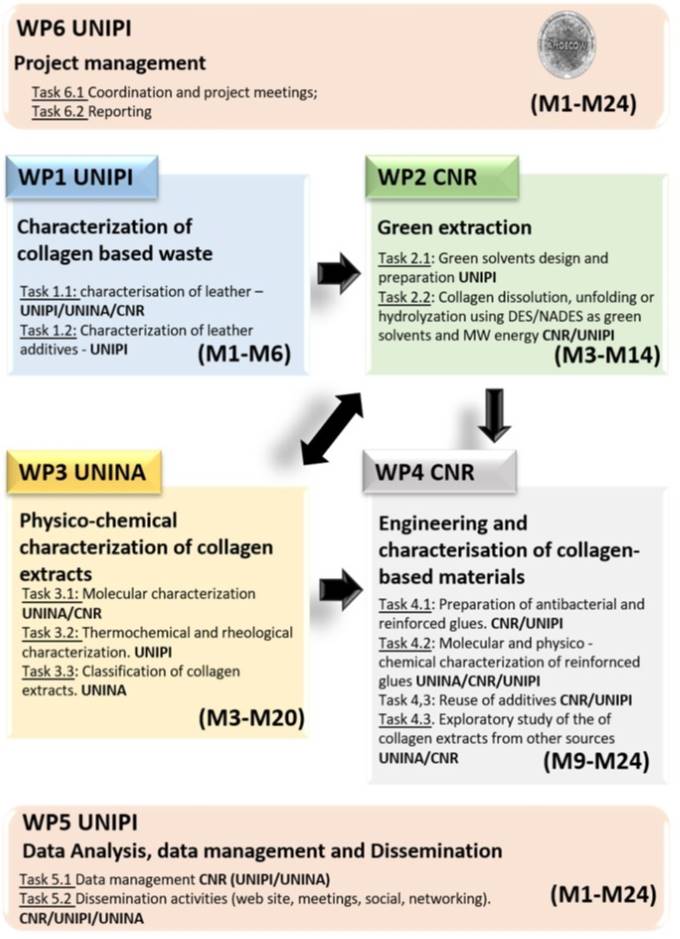WP 1 Characterization of collagen based waste
Leading partner UNIPI
Objectives. This work package aims at offering a molecular basis to support the design of extraction procedures of collagen and valuable additives from leather wastes and improve the traceability of the supply chain in leather industry by providing a chemical and physical methodology for the product characterization.
Task 1.1 A selection of various analytical methods will be employed to investigate the morphological, physical and chemical properties of the tanned leather.
Task 1.2 This task is focused on the characterization of additives (e.g. dyes and tanning agents) that remain free after the process and can therefore be extracted for reuse.
WP 2 Green extraction
Leading Partner CNR
Objectives. Implementation of the innovative use of DES in combination with MWs to extract collagen and valuable additives – tannins and dyes – from leather wastes at different levels of the tanning process and industrial use of leather.
Task 2.1 DES and NADES will be designed considering the affinity of DES/NADES components to collagen, the knowledge acquired in WP1 and the desired effect on the extracted protein.
The obtained solvents will be analysed via a selection of methods to assess their properties.
Task 2.2 The solvents developed in the previous task will be used to extract both collagen and tanning agents from leather. The aim is to fine-tune the extraction process by adjusting the conditions under which it is carried out.
WP 3 Physico-chemical characterization of collagen extracts
Leading partner UNINA
Objectives. This work package aims at carrying out a physico-chemical characterization of extracted collagen to feed into WP2 for improving extraction procedures, and into WP4 for the design of new collagen-based materials. It will define molecular guidelines for collagen exploitation and engineering for novel, eco-friendly and sustainable CBBMs.
Task 3.1 Analytical as well as computational methods will be deployed to study the alterations on the chemical structure of collagen that occur during the extraction process.
Task 3.2 Thermal, rheological, and structural properties of collagen extracts will be characterized to determine possible correlations between the macroscopic properties of the collagen extracted solutions (strength, viscosity, and mechanical properties), collagen extraction process, starting waste and collagen molecular structure.
Task 3.2. Statistical methods of analysis will be used to classify the various collagen extracts according to the various collagen structure, hydrolysis, and crosslinking degree, in relation to the starting material and extraction protocols.
WP 4 Engineering and characterization of collagen-based materials
Leading partner CNR
Objectives. Design and deliver antibacterial and reinforced glues formulated with green solvents (NADES) and produced through green chemistry with the assistance of microwaves and laser crosslinking. Exploratory research into re-use of collagen from different sources and extracted valuable additives.
Task 4.1 Antibacterial and reinforced glues will be prepared with the collagen extracted in WP2; the exact composition will be tuned to reach optimal performance for the relative task of the adhesive.
Task 4.2 The glues produced in the previous task will be characterized by a variety of analytical methods to assess the correlation between the properties of the new material and the collagen molecular structure.
Task 4.3 Additives characterized in WP1 and extracted in WP2 will be tested for further reuse by tanning a sample of WA1 at the conditions of the tanning process. The feasibility of the direct use of tannin/DES-2 mixture obtained after the MAE/DES-2 process will be investigated as well.
Task 4.4 This task will study the possibility to use other collagen sources (e.g. fisheries waste) as starting materials for new CBBMs.
WP 5 Data analysis, data management and dissemination
Leading partner UNIPI
Objectives. This WP is focused on the collection, analysis and dissemination of data, as well as the communication and dissemination of the project results to the general public, stakeholders, and scientific community.
Task 5.1 This task will include data collection and analysis in reports and publications, the definition and put into practice of the related activities ensuring accuracy and standardization of the data. This task interacts with scientific/technical and exploitation tasks, dissemination and communication.
Task 5.2 A comprehensive dissemination and communication campaign will be designed and implemented. The dissemination will occur via workshops, an official website, social media, conferences, publications and other suitable means of communication.
WP 6 Project management
Leading partner UNIPI
Objectives. This WP is dedicated at the project management.
Task 6.1 The coordinator will organize, implement, and follow-up a kick-off meeting and face to face following meetings (2 per year). Additional technical meetings through web-based means as well as technical visits will be convened when and where necessary. The progress and results will be reported in the periodic activity report.
Task 6.2 The coordinator will take care of the data collection and editing with the cooperation of all partners of two reports at months 12 and 24 that will include unpublished experimental data and data selected for scientific publications in international journals.



